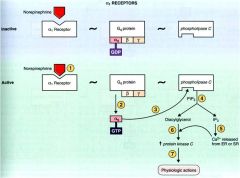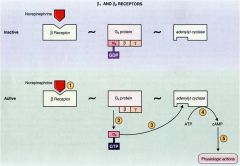![]()
![]()
![]()
Use LEFT and RIGHT arrow keys to navigate between flashcards;
Use UP and DOWN arrow keys to flip the card;
H to show hint;
A reads text to speech;
55 Cards in this Set
- Front
- Back
|
what are the characteristics of a drug which acts close to the end organ when modulating the autonomic nervous system?
|
produces most selective response with the least side effects
|
|
|
drugs which act on ganglia effect what nervous divisions of the autonomic nervous system?
|
both parasympathetic and sympathetic since both are located in ganglia
|
|
|
where will drugs that modulate nervous function act to have the most wide spread effects?
|
the CNS
|
|
|
what are the 2 neurotransmitters used to mediate transmission in the PNS?
|
Acetylcholine and norepinephrine
|
|
|
which NT is used at the pre/postganglionic neuron synapse for both parasympathetic and sympathetic divisions?
|
acetylcholine
|
|
|
what NT is used at the postganglionic neuron/end organ synapse in parasympathetic division?
|
acetylcholine
|
|
|
the NT used in most postganglionic neuron/end organ for the sympathetic division is?
|
norepinephrine
|
|
|
what is the exception to the sympathetic postganglionic/end organ synapse use of norepinephrine?
|
muscarinic acetylcholine receptors on sweat glands
|
|
|
what type of receptors are stimulated by norepinephrine with the sympathetic nervous division?
|
alpha and beta adrenergic receptors
|
|
|
what NT is used at the somatic efferent neuron at the end plate region on skeletal muscle?
|
acetylcholine
|
|
|
what inactivates acetylcholine in the synaptic cleft?
|
acetylcholinesterase in the junctional folds
|
|
|
what is the third NT that is released by the post-ganglionic sympathetic neurons at the synaptic cleft with renal vascular smooth muscle?
|
dopamine
|
|
|
sympathetic preganglionic neurons arise from which regions of the CNS?
|
thoracic and lumbar regions of the spine
|
|
|
parasympathetic preganglionic neurons arise from what regions of the CNS?
|
nuclei in brainstem, and sacral segments of the spinal cord
|
|
|
describe the position in regards to the end-organ of most parasympathetic ganglia?
|
near the end-organ (organ wall) as compared to the sympathetic which is near the spinal cord (chain ganglia)
|
|
|
which tend to be longer, preganglionic sympathetic or parasympathetic?
|
parasympathetic since they have to go farther to reach ganglia
|
|
|
describe the ratio of preganglionic neurons to postganglionic neurons for the sympathetic and parasympathetic divisions of the autonomic nervous system?
|
in sympathetic there are more postganglionic than pre, but in parasympathetic it is 1:1
|
|
|
where does the split in innervation between the cranial nerves and the sacral region become apparent for parasympathetic action?
|
upper 2/3 of large intestine is CN X where as the lower 1/3 of large intestine and everythin below is from sacral parasympathetic input
|
|
|
Describe the process of propagation of a nervous inpulse in the PNS?
|
1. Syn. & storage of transmitter.
2. Action potential depolarizes cell. 3. Depol. activates Ca channels. 4. Vesicle fuses with plasma membrane & releases transmitter. 5. Transmitter crosses cleft & binds to postsynaptic receptor 6. Transmitter is removed from receptor and is *Degraded by enzymes in cleft *Taken up by presynaptic cell 7. Postsynaptic intracellular signaling molecules are degraded. |
|
|
what are SNARE proteins which are found in the pre-synpatic membranes of neurons?
|
they hold vesicles with NT's near the cell membrane and upon sensing calcium allow vesicles to fuse with membrane spilling NT's into the synaptic cleft
|
|
|
describe the action of tetanus or botulinum toxins?
|
they selectively cleave snare proteins causing release of NT's
|
|
|
what is the function of Hemicholinium?
|
inhibits the high affinity Na+-choline cotransporter preventing the formation of acytelcholine in the neuron
|
|
|
what is the function of Vesamicol?
|
inhibits the H+-Ach antiporter that transports Ach into storage vesicles
|
|
|
what is the function of Botulinum toxin?
|
prevents calcium induced fusion of vesicles with plasma membrane by cleaving SNARE proteins
|
|
|
what is the function of Muscarinic and Nicotinic Antagonists?
|
block their respective receptors in the postsynaptic cell
|
|
|
what is the function of AChE Inhibitors ?
|
inhibit membrane bound acetylcholinesterase from degrading ACh into choline and acetate
|
|
|
Catecholamines are all synthesized from?
|
tyrosine
|
|
|
describe the process by which tyrosine gets to epinephrine including the names of intermediates and the chemical process between each intermediate
|
1. tyrosine is hydroxilized to form LDOPA
2. LDOPA is decarboxylized to form dopamine 3. Dopamine is hydroxylized to form norepinephrine 4. CH3 is added to norepinephrine to form epinephrine |
|
|
what is the function of alpha-Methyltyrosine?
|
inhibits tyrosine hydroxylase which is the rate limiting step in catecholamine synthesis
|
|
|
what is the function of Cocaine?
|
inhibits the selective NE transporter that takes released NE back into the presynaptic terminal
|
|
|
what is the function of Reserpine?
|
inhibits the vesicular monoamine transporter (VMAT) involved in filling or refilling of synaptic vesicles with dopamine or NE respectively
|
|
|
what is the function of Clonidine?
|
it is an alpha2- agonist, that stimulates presynaptic autoreceptors resulting in decreased release of NE
|
|
|
what is the function of alpha1 ,beta1,& beta2 antagonists?
|
block their respective post-synaptic receptors
|
|
|
Muscarinic receptor M1 =?
|
CNS and presynaptic autonomic ganglia
|
|
|
Muscarinic receptor M2 =?
|
heart
|
|
|
Muscarinic receptor M3 =?
|
smooth muscle
|
|
|
Nicotinic Receptors Nm =?
|
skeletal muscle
|
|
|
Nicotinic Receptors Nn =?
|
postganganglionic autonomic neurons, adrenal chromaffin cells
|
|
|
what type of receptors are all nicotinic receptors?
|
ligand-gated cation-selective channels
|
|
|
all muscarinic receptors are what type of receptor
|
G-protein-linked transmembrane
|
|
|
where can the adrenergic receptor alpha1 be found?
|
postsynaptic effector cells, especially smooth muscle
|
|
|
where can the adrenergic receptor alpha2 be found?
|
presynaptic adrenergic nerve terminals, platelets, lipocytes
|
|
|
where can the adrenergic receptor beta1 be found?
|
heart
|
|
|
where can the adrenergic receptor beta2 be found?
|
postsynaptic vascular smooth muscles
|
|
|
where can beta3 adrenergic receptors be found?
|
lipocytes
|
|
|
describe the process of signal tranduction from binding of NT to physiologic actions?
|

.
|
|
|
describe the mechanism of action of beta1 and beta2 adrenergic receptors
|

.
|
|
|
what is the location of muscarinic M3 receptors?
|
exocrine glands
|
|
|
what is the location of muscarinic M2 receptors?
|
myocardium
|
|
|
what is the effect of binding norepinephrine with alpha1 adrenergic receptors? (2)
|
1. vascular smooth muscle contraction
2. genitourinary smooth muscle contraction |
|
|
what is the effect of binding norepinephrine with beta1 adrenergic receptors? (2)
|
1. increased chronotropy and inotrpy in the heart
2. increased AV-node conduction velocity in the heart |
|
|
what is the effect of binding norepinephrine with beta2 adrenergic receptors? (2)
|
bronchiolar smooth muscle relaxation
|
|
|
what is the effect of binding norepinephrine with alpha2 adrenergic receptors? (2)
|
decreased norepinephrine release from nerves
|
|
|
Increased BP, HR, sphincter tone, gluconeogenesis, glycogenolysis, lipolysis, dilated pupils, bronchioles, distant vision, blood diverted to skeletal muscles would be seen with?
|
sympathetic stimulation
|
|
|
Increased GI motility & secretions, contracted bronchioles, pupils and ciliary muscle, decreased HR, voiding urine would be seen with?
|
parasympathetic stimulation
|

